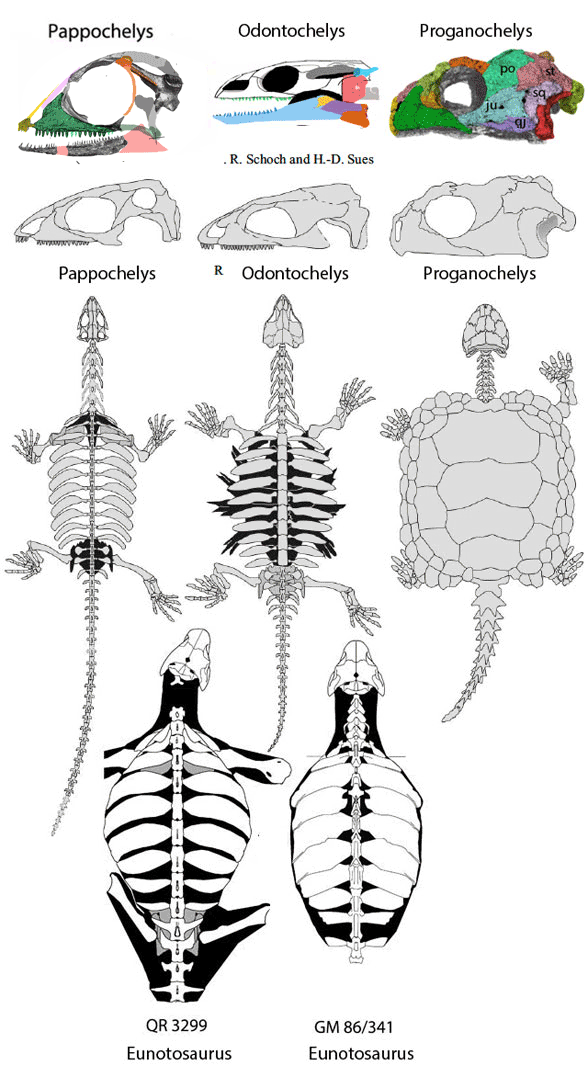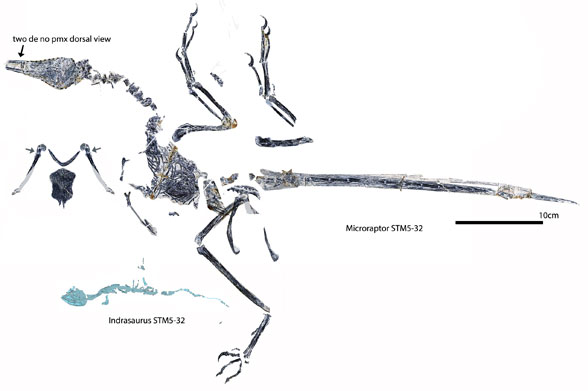A new mammaliaform, Microdocodon,
(Zhou et al. 2019; Figs. 1–4; Middle Jurassic, 165 mya) is exceptionally well preserved and complete, down to the smallest details. According to the authors, those details include “complex and saddle-shaped hyoid bones (Fig. 1), like those seen in modern mammals.”

Figure 1. From Zhou et al. 2019, colors added. Microdocodon is in yellow. The two taxa in gray are derived members of Glires and do not nest in the LRT where shown here. It is obvious from looking at this evolutionary progression that the two highly derived gnawing taxa do not document a gradual accumulation of derived traits, like the remaining plesiomorphic taxa do.
Timing?
Microdocodon was found in strata 40 million years into the Jurassic, some 40 million years after the appearance of the first mammal, Megazostrodon in the large reptile tree (LRT, 1545 taxa). Pre-mammal cynodonts lived alongside mammals throughout the Mesozoic.
H-shaped, articulated hyoids were unexpected in such a primitive cynodont
and a dozen news organizations picked up on the unexpectedness of this story. If valid this would suggest that a muscularized throat was present phylogenetically before the genesis of the milk-suckling clade, Mammalia.

Figure 2. Microdocodon throat region. Are those bones hyoids or fingers? If hyoids, then where are the fingers? Note the displaced radius (olive green) reaching toward the throat. Only impressions of once present (or still buried) fingers are present on the right limb.
Unfortunately,
there may be reason to doubt the identity of these bones. Are they hyoids? Or fingers? If the mystery bones are indeed hyoids, then the fingers are missing. If fingers, then the hyoids are missing, which takes all the surprise and wonder out of the Zhou et al. paper.

FIgure 3. Microdocodon in situ. Plate and counter plate plus colors added. Manus, pelvis and pes reconstructed. The recombining of plate and counter plate is something that does not work as well in print.
From the abstract
“We report a new Jurassic docodontan mammaliaform found in China that is preserved with the hyoid bones. Its basihyal, ceratohyal, epihyal, and thyrohyal bones have mobile joints and are arranged in a saddle-shaped configuration, as in the mobile linkage of the hyoid apparatus of extant mammals. These are fundamentally different from the simple hyoid rods of nonmammaliaform cynodonts, which were likely associated with a wide, nonmuscularized throat, as seen in extant reptiles. The hyoid apparatus provides a framework for the larynx and for the constricted, muscularized esophagus, crucial for transport and powered swallowing of the masticated food and liquid in extant mammals. These derived structural components of hyoids evolved among early diverging mammaliaforms, before the disconnection of the middle ear from the mandible in crown mammals.”
The big question is:
If those are indeed hyoids, then where are the fingers? EVERYTHING else is present and visible on this perfectly preserved fossil, except, apparently, the fingers of both hands.
Further complication:
I looked closely at the purported hyoids and found they
- included unguals
- began at the wrist
- were articulated like fingers
- had all the proportions and correct number expected in a typical manus from that node on the LRT (Fig. 5).
Often enough,
when bones you expect are missing AND similar bones you don’t expect are present, you should suspect that a misidentification is taking place.

Figure 4. Microdocodon skull, plate and counter plate, colors added.
After phylogenetic analysis
Microdocodon nests at the base of the Tritylodontidae (Oligokyphus and kin) + (Riograndia + Chaliminia) clade. These are therapsids retaining a primitive quadrate/articular jaw joint, not like a mammal with a squamosal/dentary jaw joint.
At this point it is probably good to remember
that the most primitive mammals do not suckle. Prototherians, like echidnas and platypuses lick their mothers milk from sweat puddles on her belly. Only metatherians and eutherians have infants that suckle on their mothers’ teats, which is several nodes up the ladder from Microdocodon.
A docodont?
The authors considered Microdocodon a small member of the Docodonta, a clade traditionally defined by dental and mandible traits. Unfortunately, Microdocodon does not nest in the LRT with other clade members listed on the Wikipedia page. As we’ve seen many times, dental traits can converge.
The phylogenetic analysis of Zhou et al. employs “tritylodontids” as a suprageneric taxon nesting outside of Pachygenelus, (the opposite of the LRT) derived from Thrinaxodon and Massetognathus. To their peril, Zhou et al. include a long list of multituberculates, but no carpolestid and plesiadapid sister taxa recovered by the LRT. So taxon exclusion is a problem as highly derived multituberculates arise in Zhou et al. prior to primitive prototherians (Fig. 1). Also mis-nested in the Zhou et al analysis, the early and basal metatherian, Eomaia and the basal prototherian, Juramaia, nest as derived eutherians. These are all red flags, probably arrived at by an over-reliance on dental traits and the most typical problem in vertebrate paleontology: taxon exclusion. The LRT minimizes taxon exclusion because it tests such a wide gamut of taxa.

Figure 5. Microdocodon pectoral and forelimb reconstruction from DGS traced elements. Those fingers were originally considered hyoid elements. Yes, those are elongate coracoids, typically found in members of the Tritylodontidae.
But wait! All is not lost.
Microdocodon fills an important gap leading to the Tritylodontidae in the LRT. So it can still be exciting and newsworthy for this overlooked reason.
The pre-mammal/pre-tritylodontid split occurred
by the Middle Triassic, which gives Middle Jurassic Microdocodon plenty of time to evolve distinct traits. And it did. The snout is longer than typical. The medial metatarsals were atypically longer than the others. Tiny phalanges 3.2, 4.2, 4.3 and 5.2 reappear after disappearing several nodes earlier. That bit of atavism is interesting. The limbs are long and gracile with reduced interoseal space between the crural and ante brachial elements, mimicking/converging on more derived mammals.

Figure 6. Subset of the LRT focusing on basal Therapsida and Microdocodon’s nesting in it.
The authors report,
“Phylogenetically, Microdocodon and [coeval] Vilevolodon are the earliest-known mammaliaform fossils with mammal-like hyoids.” Vilevolodon is a highly derived, squirrel-like member of the clade Multituberculata within the rodent/rabbit clade of Glires within the Eutheria in the LRT.
Articulated hyoids
are exceptionally rare in the early fossil record of mammals. So are basal mammals.
Everyone is looking for a headline with every new fossil specimen.
Unfortunately, as we’ve seen time and again, you can’t believe everything you read, even after PhD peer review and publication in Nature and Science. Make sure you test all novel hypotheses with careful observation and a wide gamut phylogenetic analysis.
References
Zhou C-F, Bullar B-A S, Neander AI, Martin T and Luo Z-X 2019. New Jurassic mammaliaform sheds light on early evolution of mammal-like hyoid bones. Science 365(6450):276–279.
https://www.sciencenews.org/article/flexible-bone-helps-mammals-chew-dates-back-jurassic-period
https://www.sciencedaily.com/releases/2019/07/190718140440.htm
For a dozen more popular articles: Google keyword: Microdocon.




































